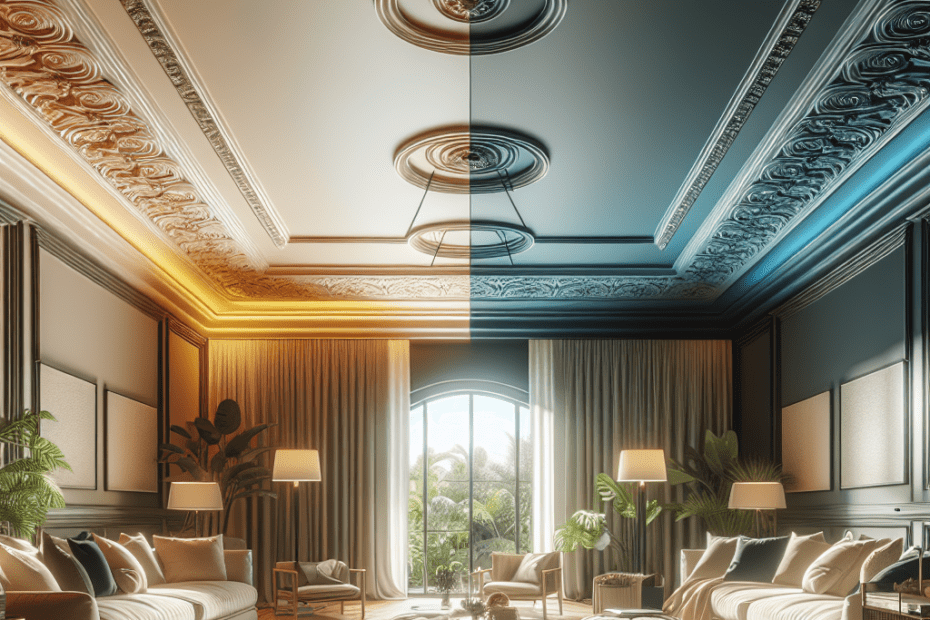“`html
The Impact of Ceiling Color on Room Perception
When it comes to designing a room, people often spend hours selecting the right furniture, carpets, and wall colors. Yet, they might not realize the dramatic effect their choice of ceiling color can have on the overall perception of the space. The wall is usually considered the centerpiece, but the ceiling stands as a silent game-changer in interior design. The choice of ceiling color can modify how large, cozy, or bright the room appears, and understanding this can unlock even more aesthetic potential. The impact of ceiling color on room perception is a key aspect that homeowners, designers, and decorators alike should consider carefully.
Understanding the Basics of Ceiling Color
While ceilings are often painted white by default, using different colors can transform the vibe of any room. Choosing colors for ceilings goes beyond aesthetics; it dictates how people experience the space.
| Ceiling Color | Room Perception |
|---|---|
| White | Makes the room feel larger and more expansive |
| Dark | Creates a cozier and more intimate atmosphere |
| Light Pastels | Adds warmth and a soft welcoming ambiance |
The Psychological Effects of Different Ceiling Colors
Color psychology plays a significant role in determining how a space is perceived. White ceilings can make rooms look larger and airier, while darker colors can add depth and create focus.
- White Ceilings: White is associated with cleanliness and purity. It can make spaces appear larger than they are, often enhancing natural light. According to a study by Sherwin-Williams, 59% of people surveyed preferred neutral colors like white to give their homes a sense of cleanliness and modernity.
- Dark Ceilings: Utilizing deeper shades like navy or charcoal can introduce elegance and drama. A dark ceiling can make a room with height constraints feel cozier. A survey in House Beautiful revealed that 35% of designers often suggest darker ceilings when aiming for a chic, sophisticated look.
- Light Pastels: Light colors like soft blue or mint can infuse a room with tranquility and light, making the space feel contained but relaxed. These colors are often recommended for bedrooms or relaxation spaces.
How Ceiling Color Influences Room Dimensions
Using specific ceiling colors can manipulate perceived room dimensions. When painted a lighter shade, ceilings create an illusion of height, making the room feel expansive. Conversely, a darker ceiling visually lowers the height, which can be beneficial in too-tall rooms needing that close-knit atmosphere.
Color perception is essential in smaller spaces, such as bathrooms and home offices, where spatial constraints matter even more. Bright ceilings there can potentially unlock a psychological effect of spaciousness, emphasizing openness.
Tips for Choosing the Right Ceiling Color
- Consider Natural Light: Rooms bathed in light can afford darker ceilings without feeling enclosed, which provides an eye-catching contrast.
- Align with Room Purpose: Since different colors provide varying psychological effects, choose the tone based on the room’s primary function. Bedrooms might benefit from pastels, while a creative workspace might indulge in deeper hues.
- Evaluate Wall Color: Ensure the ceiling complements the walls without creating discordance. A consistent palette will provide harmony across surfaces.
In conclusion, selecting the right ceiling color isn’t merely a matter of preference but a strategic choice to modify space perception. The effect of ceiling color on room perception is substantial, creating environments that can either expand or contract visually.
Key Takeaways
- The ceiling can dramatically influence a room’s perceived size and ambiance.
- White ceilings typically make rooms appear larger.
- Darker ceilings can create cozy, intimate spaces.
- Selecting ceiling color based on room purpose and natural light can provide optimum results.
- Color can influence the psychological response and spatial perception considerably.
FAQs
-
Q: What ceiling color makes a room look bigger?
A: White or lighter shades generally make a room feel larger and more open.
-
Q: Are dark ceilings in fashion?
A: Yes, dark ceilings are trending for their modern, elegant feel and are often chosen for style and warmth.
-
Q: Can ceiling color affect mood?
A: Absolutely. Color psychology suggests that colors evoke different feelings, with lighter shades being uplifting and darker hues providing calmness.
-
Q: Should ceiling color match the walls?
A: It doesn’t have to match, but the colors should complement each other to maintain harmony in the design.
-
Q: What’s the best ceiling color for bedrooms?
A: Light pastels or neutrals are recommended as they tend to create a calming, restful atmosphere.
“`
